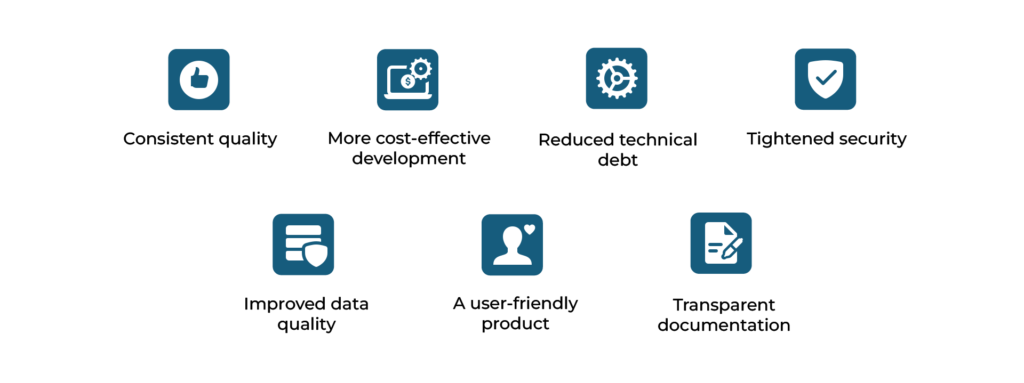Software quality management is paramount. Without careful quality assurance, planning, and controls, you risk finding critical issues and vulnerabilities after deploying your app. On the contrary, properly incorporated practices help companies to maintain top-notch quality across projects.
Unicsoft has spent years perfecting its quality management system. We have made sure our methodology follows ISO 25010 and other relevant standards so that our clients get user-friendly, reliable, and secure software.
This article will tell you about software quality management standards and give you a glimpse of our methodology. You’ll also understand why you should always stick to companies with well-oiled quality assurance systems.
After receiving the ISO 25010 certification, Unicsoft will become an even more attractive vendor for clients seeking or required to build high-quality software products. This certification serves as proof of our commitment to adhering to global standards for software quality management. With Unicsoft as a software development partner, one can be confident in the quality of the end product, knowing that it has been developed with a focus on meeting the highest standards of quality and reliability.
What is software quality management?
Quality management is an umbrella term for processes and tools that help achieve the desired quality in production. In software engineering, these processes address both functional (like application design and user-facing features) and non-functional (architectural elements, business logic, and security) qualities.
Quality management systems have three principal aspects: planning, control, and assurance.
Quality planning
Quality plans are documents that specify the product’s technical specifications, customer experience requirements, and necessary legislation. In addition, the plan outlines the roles and responsibilities of engineers during the software development lifecycle.
Quality control
Quality control refers to metrics and key performance indicators (KPIs) for the quality management system. These measurements should show you if the product meets the success criteria.
Quality assurance
Assurance helps the project comply with your organizational policies and practices. It includes monitoring software development activities and continuous reviews of deliverables.
You might be surprised, but competent quality management isn’t as common as it should be. This may invite critical problems while and after you deploy your product.
Why do you need software quality management?

A systematic approach to quality management can help you make sophisticated applications that meet intent. Some of the advantages it can give to your company include:
- Precise assessment. Assessing quality can be challenging, and metrics like user satisfaction and usability are subjective and cannot be measured in absolute terms. However, a quality assurance framework provides a structure for evaluating even subjective metrics such as user satisfaction.
- Compliance with requirements. Development becomes more challenging proportionally to the software’s complexity. A microservices-based application may involve millions of operations every day. However, proven software quality practices can help you meet business requirements at every step of development.
- Money-saving. Without proper quality assurance, critical issues can sneak into the final version. This can accumulate your technical debt, leading to expensive reworks. Nearly a third of CIOs surveyed in McKinsey’s 2020 report state that over 20% of their IT budget goes to resolving technical debt issues.
- Early issue detection. Quality assurance lets you detect vulnerabilities early in the product’s life cycle. As such, you have more time to deal with security backdoors, compliance issues, and other risks.
- Continuous improvement. Software quality management is more than just testing. Reputable companies don’t just test software after the development — they incorporate in-depth reviews into the pipeline. Quality assurance also helps you identify and continuously improve your processes’ deficiencies.
Finally, a reliable quality management process and certification indicate credibility. It also makes development more predictable, as you can expect a certain level of craftsmanship, reliability, and security based on the company’s previous projects.
Software quality management practices
So, what standards and practices does Unicosft follow to guarantee the top-notch quality?
ISO/IEC 25010 standard

We stick to ISO 25010:2011 software quality standards as a baseline for our projects. This lets us assess the product’s quality based on the following functional and non-functional characteristics:
- Usability — Whether the software meets its intended purpose and reaches its target audience.
- Functional stability — Whether software can provide the required functionality and support specific tasks.
- Reliability — How your application handles regular operation and restores its functionality (in case of interruption or failure).
- Compatibility — Whether software can work seamlessly with other products and architectural components.
- Portability — How software works in different environments and if its parts can be reused for other projects.
- Efficiency — How the app utilizes available computing resources, handles the load, and exchanges data with other systems.
- Maintainability — How easy it is to modify the software and how it adapts to changes in the environment.
- Security — How the software protects confidential data, monitors activity and authorized users, and complies with industry regulations (like GDPR, PCI DSS, or HIPAA).
By evaluating each software component against these metrics, Unicsoft can define its quality and ensure it meets both client and market standards. This approach guarantees that the company software solutions provide optimal usability, stability, reliability, compatibility, portability, efficiency, maintainability, and security.
Software quality for products in use

We go beyond the usual ISO 25010 metrics. Some can be applied to minimal viable products (MVPs) and released apps.
- Satisfaction — Shows how comfortable users are with the product based on its perceived goals (how good it is at fulfilling their needs).
- Context coverage — The degree to which your product is useful beyond the initially specified goals.
- Trust — How willing the users are to entrust their personal information and files to your software.
- Risk tolerance — How your product can mitigate threats outside of security vulnerabilities (like economic risks and market shifts).
Some of these indicators are quite ambiguous at first glance. Still, our team has found systematic ways to gauge metrics like satisfaction (typically using questionnaires).
Software quality control loop
The quality control loop helps us address errors and deviations from requirements throughout production. Before we start development, we prepare a quality model and plan.
Each software component is matched against our quality model using testing, reviewing, and problem analysis. Each evaluation produces an exhaustive report, which is sent back to the development team that incorporates it for the next iteration of the software. This process repeats until the product matches the desired level of quality.
We implement testing into our continuous integration and deployment (CI/CD) pipeline. The AI-powered software runs security scans, code reviews, and dependencies issues. This helps us automate most of the routine processes so we don’t overload our quality engineers.
Continuous quality assurance
Quality assurance specialists (quality engineers) are the ones who make sure the final product meets quality standards. But the role goes further than testing and reviewing.

In our company, quality engineers:
- Develop a quality model with relevant metrics based on technical requirements and business goals
- Make sure the quality procedures and protocols adhere to quality control guidelines
- Coordinate investigation of quality issues and approve corrective actions after remediation
- Monitor and support quality control tools and processes
- Organize technological, security, and compliance audits
- Assess and manage risk throughout the project’s life cycle
- Ensure every quality assurance process is sufficiently and correctly documented
These responsibilities are not exhaustive — our quality specialists can assume more roles if the project demands it. The goal is to ensure the product’s quality meets and possibly exceeds the client’s expectations.
Now, we want to demonstrate how we have organized our software development process around these practices.
Our quality management software system
Here’s the thing. Perfectionism is not software quality control. It is, first of all, a thought-out system.
Without a solid methodology, quality assurance becomes too lengthy and resource-intensive. However, using Agile principles and DevOps practices, we have perfected an approach that helps us deliver products on time.

Requirement gathering
We validate the comprehensiveness of your technical requirements, design specifications, and business objectives. Then, we supply you with acceptance criteria and agree on quality standards.
If your product is already deployed, we perform an in-depth audit to evaluate the product’s efficiency, fault tolerance, and compliance with industry standards. This assessment also helps us measure potential technical debts.
Quality model and testing configuration
Our team generates a quality model and guidelines for your software. The quality model will outline our control criteria to evaluate your product’s properties. Guidelines will assist quality engineers in planning and testing.
We also outline testing cases, scenarios, and scripts. The case details the preconditions, procedure, and inputs; scenarios describe realistic postconditions (results); and the scripts include instructions for verifying specific features.
Quality assurance for each iteration
Each software version goes through rigorous testing. Assisted by guidelines, quality engineers review code to look for programming mistakes, inefficiencies, and vulnerabilities. At this stage, we must verify that the software fulfills basic usability, efficiency, and stability requirements.
The software goes through unit testing (examining every component separately) and integration testing (verifying how the system works as a whole). In the latter stage of development, we also validate the software against end-user requirements.
Quality assurance specialists analyze the outcomes, identify causes of problems, and prepare remediation strategies. The software product is then delivered to the development team for another cycle.
Documenting outcomes
Our company documents all test artifacts and logs during software development. We share the reports with your team in detail, so your team can reproduce testing scenarios if needed.
Consistent documentation also lets us measure the efficiency of our team. Our company holds retrospective meetings to analyze issues found during development so that we can improve our processes.
The project is ready only when a working piece of software meets all requirements and quality standards.
How does software quality control benefit your projects?

Our software for quality management systems helps us build applications according to the strictest requirements. What else does this mean for our clients?
- Consistent quality. Software quality system means we adhere to the same standards for every project. You can get a sense of our expertise and learn what to expect by looking at our previous work.
- More cost-effective development. High reliability and maintainability standards mean you don’t have to spend extra resources on expensive reworking.
- Reduced technical debt. We prioritize efficient coding practices and scalable architecture instead of easy-to-implement solutions.
- Tightened security. Your software will have robust authorization mechanisms and appropriate role-based permissions. We also make sure it complies with relevant data security and privacy laws.
- Improved data quality. Our team ensures your application is interoperable, meaning it can safely and efficiently exchange data with other systems.
- A user-friendly product. We actively incorporate metrics that improve your product’s chances of satisfying your target audience.
- Transparent documentation. Meticulous documentation means your in-house team can easily support your product after release.
ISO 25010 isn’t the only standard we follow. Unicsoft recently upgraded its certification with ISO/IEC 9001 for our ability to effectively conform to customer and regulatory requirements. We’re also a certified ISO/IEC 27001 company with first-rate information security.
Qualified software quality management with Unicsoft
An organized software quality management system makes development more predictable. You will know what level of reliability, efficiency, and security you can expect. In short, it makes the process safer in many ways.
That doesn’t mean ISO 25010 and related standards can be thought of as a ready-made checklist. The key is organizing the quality assurance process to accurately measure these metrics and deliver products on time.Do you want to build five-star software or upgrade your existing applications? Contact us if you want to talk business.







